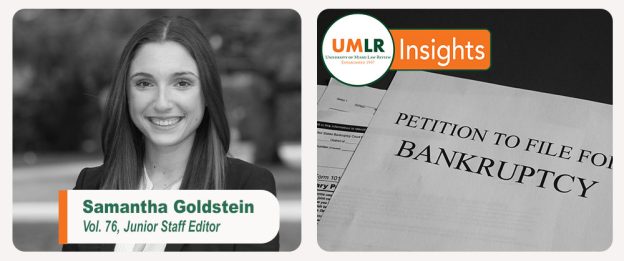SAMANTHA GOLDSTEIN—On February 25, 2022, New Jersey U.S. Bankruptcy Court Judge, Michael Kaplan, allowed healthcare giant Johnson & Johnson’s spinoff company, LTL Management, LLC (“LTL Management”), to proceed with its filing of chapter 11 bankruptcy. Johnson & Johnson’s bankruptcy strategy evolved due to the 38,000 lawsuits claiming that its talc-based baby powder was contaminated with asbestos and caused cancer. As a result of these lawsuits, Johnson & Johnson created LTL Management, and then assigned all legal liability for the claims to the new company prior to its bankruptcy filing. The Official Committee of Talc Claimants, along with several other parties, filed motions to dismiss LTL Management’s bankruptcy case pursuant to section 1112(b) of the Bankruptcy Code, on the basis that the case was not filed “in good faith.” Judge Kaplan’s denial of the motions to dismiss, along with his grant of LTL Management’s motion to stay prosecution of actions, represent the first acceptance of this kind of bankruptcy strategy outside of North Carolina.
The bankruptcy maneuver that Johnson & Johnson employed is called a “divisive merger,” otherwise commonly referred to as the “Texas Two-Step.” The first step in the Texas Two-Step allows a company to split itself into two companies. The company can then allocate its assets and liabilities between the two entities however it pleases. Increasingly, companies are allocating all their tort liabilities to one entity, while maintaining the majority of their assets in the other entity. Although this kind of strategy is typically classified as a fraudulent transfer, it is permitted under Texas law, which defines a “merger” to include “the division of a domestic entity into two or more new domestic entities or other organizations.”
The second step of the Texas Two-Step occurs when the new liability holding entity files for bankruptcy. This action shields some or all of the assets of one entity from creditors, while providing the liability bearing entity with the shield of the Bankruptcy Code’s automatic stay. The automatic stay places an immediate freeze on all adverse actions that creditors could take against the liability bearing entity. In acknowledging its use of the Texas Two-Step, LTL Management explained that the purpose of its bankruptcy maneuver is to “produce an equitable resolution of both current and future talc claims by means of a settlement trust, established pursuant to § 105 or § 524(g) [of the Bankruptcy Code], that can promptly, efficiently, and fairly compensate claimants.”
Despite the corporation’s assertions, this bankruptcy execution strategy is widely controversial, as it is viewed as allowing massively profitable corporations to delay mass tort litigations and potentially secure bankruptcy discounts. Critics have complained that “[t]he bankruptcy code was never intended to be abused in this way by massively profitable corporations as a means to delay or prevent cancer victims from having their day in court.”
In his opinion, Judge Kaplan stated, “[t]he Court is aware that its decision will be met with much angst and concern . . . . The Court remains steadfast in its belief that justice will be best served by expeditiously providing critical compensation through a court-supervised, fair, and less costly settlement trust arrangement.” As a result of Judge Kaplan’s decision, the thousands of lawsuits filed in different courts throughout the United States against LTL Management will be funneled through the U.S. Bankruptcy Court, leaving one judge to decide on payouts.
Due to its controversial nature, the Texas Two-Step has been discussed in Congress. Chairman Sheldon Whitehouse led a Senate Judiciary Subcommittee titled “Abusing Chapter 11: Corporate Efforts to Side-Step Accountability Through Bankruptcy.” At the hearing, Whitehouse outlined his concerns regarding the Texas Two-Step, including how the maneuver violates fundamental principles of bankruptcy, denies people their day in court, encourages forum-shopping by corporations, and prolongs the length of time before plaintiffs can recover. Whitehouse signaled at the hearing that he plans to pursue legislative action.
In addition to Johnson & Johnson’s case, Whitehouse’s concerns likely stem from the recent influx of other Texas Two-Step cases that have succeeded in recent years. In 2017, Georgia-Pacific effectuated a divisive merger that created the new entity Bestwall LLC (“Bestwall”). Bestwall was then assigned asbestos-related liabilities and subsequently sought chapter 11 protection. In 2019, CertainTeed Corporation performed a divisive merger that created CertainTeed LLC, which retained 97% of the company’s assets and non-asbestos liabilities, and DBMP LLC (“DBMP”), which inherited the company’s asbestos liabilities. DBMP thereafter filed for chapter 11 bankruptcy. With the Texas Two-Step’s recent approval in New Jersey, time will tell if other courts throughout the country continue to accept its use.






